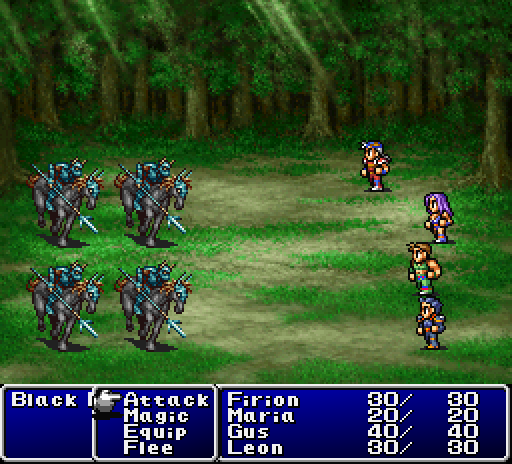Even though we didn't really get II & III until just recently in revamped forms, I think the first game was strong enough to provide a foundation to last until the SNES games came along. Although I've only played select entries in the series, I have completed the first game possibly more than any other game out there. There are fans that continue to devise interesting new challenges (e.g. single white mage playthrough) and people like me that just feel a need to play through it again every few years. A truly great accomplishment.
Final Fantasy Retrospective: The Famicom Years
Join PixlBit as we celebrate the 25th anniversary of Final Fantasy in style!
Final Fantasy II: Establishing the Precedent for Change


With Final Fantasy becoming a smash hit for Square, moving forward with a sequel was an obvious course of action. Since the first game had been created as a self-contained adventure, the world and characters didn’t really lend themselves to a direct sequel. So Hironobu Sakaguchi came up with an unprecedented and slightly controversial idea: create a game sequel that didn’t retain any major elements from its predecessor.
Final Fantasy II was developed by the same core team as the first game, but with a few additional hands on deck. Sakaguchi again created the concept, with Kenji Terada writing the scenario. Sakaguchi assumed the role of director, which he would continue as until Final Fantasy V. With a successful game system already under their belts and a larger creative team, Final Fantasy II was released less than a year after the first game (364 days later, to be accurate).
Although Final Fantasy II is instantly recognizable as a sequel to the first game thanks to a similar graphics style, the iconic battle screen, and the overworld map, much of the game is completely different from Final Fantasy. This would set a precedent for the series: from this point forward, each major release of Final Fantasy would be set in a different world with different characters and themes.

Certain elements would carry forward, of course. Final Fantasy II has the same magic spells as the first game, and these would become staples for the series. Similarly, the game features many monsters that would become a hallmark of the franchise. Final Fantasy II introduced two elements that would go on to define the series for many fans: the addition of the chocobo (ostrich-like birds that act as a means of conveyance) and the introduction of Cid. Cid has been in every major game since his first appearance, and though he’s always a different man, certain things about him remain the same. The core element about Cid is that he’s usually involved with airships in some way, and that’s how he makes his debut: as a pilot of an airship that the heroes use.
This would be the first game in the series to have a cast of characters with names and dialogue. The game starts out with a party of four characters: Firion, Guy, Leon, and Maria. However, Leon is lost early on in the adventure, and the story goes on to focus on the other three characters. They are joined by various guest characters. Final Fantasy II was also the first game to deal with the deaths of people in the party, as many of these guest characters leave this mortal coil during the story. While Final Fantasy was developed with the gameplay first and story second, Final Fantasy II began with the storyline, and the game mechanics were built around that.
Where Final Fantasy II differs wildly is in the way characters grow in skill. In this game, experience points were completely scrapped for a system designed to give players more control over how their party gains strength. Basically, any action taken by a character would work towards strengthening the stat that the action is associated with. So a character that attacks with swords a lot will get much better at using swords, while a party member that casts spells over and over will become a better caster. Taking damage increases defense over time, as well as contributing to the hit points of a character. It was a surprising departure from the first game, and this method for leveling up was notorious for being easily exploited. A version of this system would return in the online games of XI and XIV, but no other game in the series uses the exact progression system that II does, setting it apart from the rest of the series.

An American release of Final Fantasy II was well underway by Square Soft, the North American branch of the company, and even had box art that showed up in promotional material for upcoming Square Soft games. With the success of the first game in the U.S. it may be hard for younger gamers to understand why the game never saw the light of day here, but it’s important to consider the timeframe. By the time the translated version of Final Fantasy II would have been completed, the Super Nintendo would already be released. Instead, Square Soft decided to scrap the project and begin work on bringing Final Fantasy IV to the SNES in America. This would lead to naming confusion that would continue until Final Fantasy II would finally be released outside of Japan in 2003 for the Sony PlayStation.

Final Fantasy II was again well received in Japan, garnering a score of 36 out of 40 by Famitsu magazine. The game would go on to sell over a million copies worldwide across all of the different iterations and ports, but it remains the lowest selling game in the franchise. This is most likely due to its divisive leveling system and the fact that it took so long for the title to leave Japan.




Comments